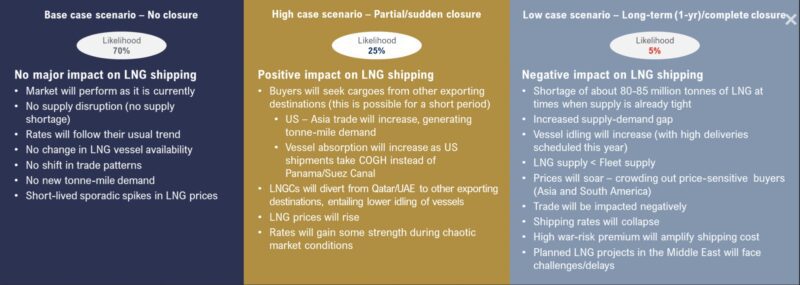Car-Shipping Companies Plunge After Trump’s Latest Tariffs
Shares of companies that haul cars across oceans plunged after President Trump widened his trade war with tariffs on vehicles not made in the US.
The escalating tensions between Iran and Israel have raised concerns over the trade of Liquefied Natural Gas (LNG) through the Strait of Hormuz, according to a report by shipping consultancy Drewry.
The Strait of Hormuz is a critical passage for LNG exports from Qatar and the UAE, and any escalation leading to its closure could affect about 1/5th of the global LNG supply.
The Strait of Hormuz is strategically significant for the Middle East and international trade, particularly for the LNG sector, as it is the only feasible passage for key LNG exporters like Qatar and the UAE.
According to Drewry, in 2023, Qatar and the UAE exported 81 million tonnes and 4 million tonnes of LNG respectively, contributing 21% to the global supply. A blockade would not only affect these exporters but would also pressure key importers to seek new supply sources.
Asian countries would feel the effects more acutely, with 70% of Qatar’s volumes exported to Asia and 20% to Europe. India and China, which source about 45% and 25% of their total LNG imports from Qatar, would face high risks. European importers, including the UK, Italy, and Belgium, would also need to source LNG from other countries if supply from Qatar becomes impassable.

Drewry believes a complete closure of the Strait of Hormuz is highly unlikely given it is also the export route for all of Iran’s oil and LPG cargoes. A closure would have severe repercussions not just for Iran but for other Middle Eastern countries that rely on the Strait of Hormuz for trade.
However, the potential closure of the strait could hit the global economy with a massive supply deficit of energy resources. It could affect 30% of oil, 20% of LNG, and 40% of LPG supplies.
The escalated tensions in the Middle East have already impacted LNG prices. According to Drewry, as of April 20th Asian Spot and TTF were up 14% and 15% week-on-week, respectively.
The extent of the supply shortage would depend on the duration of an Strait of Hormuz closure. If it were blocked for a few days or weeks, Drewry suggests the impact on the LNG market and shipping would likely be minor given the current stable demand in Europe and Asia.
If a closure extends to several weeks or months, approximately 5-6 million tonnes of supply per month from Qatar and the UAE could be stalled. This could idle about 16-17 LNG carriers per week, and affect 60-70 LNG carrier loadings per month, Drewry says.
According to Drewry, a partial closure of the Strait of Hormuz could support LNG shipping as vessels divert from the Middle East in search of new employment. This could lead to shifts in current trade patterns and increased US-Asia trade, boosting LNG shipping rates.
However, Drewry believes a longer-term closure (assuming one year) would not bode well for the LNG shipping industry. A lengthy supply shortage would tighten the market while fleet availability would increase as more vessels are idled and about 60 new LNG carriers are expected to join the current fleet this year. This could lead to vessel oversupply and consequently, a drop in the LNG shipping rates.

Sign up for gCaptain’s newsletter and never miss an update

Subscribe to gCaptain Daily and stay informed with the latest global maritime and offshore news


Stay informed with the latest maritime and offshore news, delivered daily straight to your inbox
Essential news coupled with the finest maritime content sourced from across the globe.
Sign Up